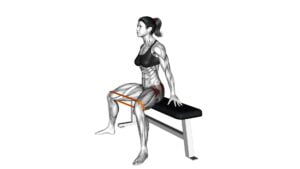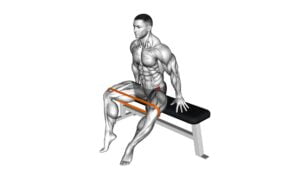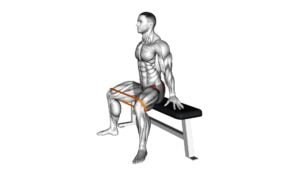Resistance Band Seated Hip Abduction (female) – Video Exercise Guide & Tips

Are you looking to strengthen your hip muscles and improve your overall fitness? Then look no further!
Watch This Exercise Video
With our Resistance Band Seated Hip Abduction exercise guide, you'll learn the proper form and set-up to target those hard-to-reach muscles.
Whether you're a beginner or an experienced fitness enthusiast, we've got variations and modifications for all levels.
Say goodbye to common mistakes and hello to maximizing results.
Let's get started on your journey to a stronger, healthier you!
Key Takeaways
- Resistance band seated hip abduction improves hip strength and stability.
- This exercise targets the gluteus medius and gluteus minimus muscles.
- It increases flexibility and range of motion in the hips.
- Proper form, alignment, and engagement of core muscles are essential for effectiveness and injury prevention.
Benefits of Resistance Band Seated Hip Abduction
You will experience significant improvements in hip strength and stability through regular resistance band seated hip abduction exercises. These exercises specifically target the muscles responsible for hip abduction, namely the gluteus medius and gluteus minimus. By using a resistance band, you can increase the intensity and effectiveness of the exercise, leading to greater gains in both strength and stability.
One of the key benefits of resistance band seated hip abduction exercises is the improvement in hip flexibility. As you perform the exercise, the resistance band provides resistance against your leg movement, forcing your hip muscles to work harder. This helps to stretch and strengthen the muscles around your hip joint, increasing their flexibility and range of motion.
Additionally, these exercises are highly effective in strengthening the glute muscles. The gluteus medius and gluteus minimus, which are often neglected in traditional lower body exercises, play a crucial role in hip stability and overall lower body strength. By targeting these muscles with resistance band seated hip abduction exercises, you can strengthen them, leading to improved hip stability and reduced risk of injuries.
In the subsequent section about proper form and set-up, we'll discuss how to perform these exercises correctly to maximize their benefits and minimize the risk of injury.
Proper Form and Set-Up
To ensure proper form and set-up for resistance band seated hip abduction exercises, position yourself on a stable chair or bench. This is crucial for maintaining balance and stability throughout the exercise.
It's important to note that hip mobility plays a significant role in overall lower body strength and function. By incorporating seated hip abduction exercises into your workout routine, you can improve hip mobility and strengthen the muscles in your hips and thighs.
Before starting the exercise, make sure you have the necessary equipment. You'll need a resistance band that's appropriate for your strength level. The resistance band should be securely looped around both legs, just above your knees. This will create resistance as you perform the hip abduction movement.
Once you're seated on the chair or bench, with the resistance band in place, keep your feet flat on the ground and your knees bent at a 90-degree angle. Engage your core muscles to maintain a neutral spine throughout the exercise. From this starting position, slowly open your legs, pushing against the resistance of the band. Pause for a moment at the end of the movement, then return to the starting position with control.
Remember to focus on maintaining proper form and alignment throughout the exercise. This will ensure that you're targeting the correct muscles and maximizing the benefits of hip mobility and strength.
Step-by-Step Guide for the Exercise
To perform the resistance band seated hip abduction exercise, position yourself on a stable chair or bench and ensure the resistance band is securely looped above your knees. Here is a step-by-step guide to help you with the exercise:
- Sit on a chair or bench with your back straight and feet flat on the floor.
- Place the resistance band above your knees, making sure it's secure and doesn't slip.
- Engage your core muscles by pulling your belly button towards your spine.
- Slowly open your legs apart, pushing against the resistance of the band.
- Keep your back straight and your feet firmly planted on the floor throughout the movement.
- Pause for a moment when your legs are at the widest point of the abduction.
- Slowly bring your legs back together, resisting the tension of the band.
- Repeat the exercise for the desired number of repetitions.
This hip abduction technique targets the outer muscles of the hips, including the gluteus medius and minimus. It helps to strengthen and tone these muscles, improving hip stability and reducing the risk of injury.
Remember to start with a light resistance band and gradually increase the tension as you become stronger. Keep proper form and control throughout the exercise to maximize its benefits.
Variations and Modifications for All Fitness Levels
One way to modify the resistance band seated hip abduction exercise for all fitness levels is by adjusting the tension of the band. By increasing or decreasing the tension, you can make the exercise more challenging or easier, depending on your fitness level.
If you're a beginner or have limited hip strength, you can start with a band that has less tension. As you become stronger, you can gradually increase the tension by using a thicker band or by doubling up the band for a greater resistance.
Another variation of the exercise is to change the position of your legs. Instead of sitting with your legs extended straight out in front of you, you can try bending your knees and placing your feet flat on the ground. This modification can help to engage different muscles in your hips and thighs.
Additionally, you can also try performing the exercise in a standing position. Simply attach the resistance band to a sturdy anchor point and stand with your feet shoulder-width apart. Hold onto the ends of the band and then perform the hip abduction movement by lifting your leg out to the side against the resistance of the band.
Remember to always listen to your body and choose the modification that suits your fitness level. It's important to challenge yourself, but also to avoid any pain or discomfort during the exercise.
Common Mistakes to Avoid
Avoid these 3 common mistakes when performing the resistance band seated hip abduction exercise to ensure injury prevention:
- Using improper form:
One common mistake isn't maintaining proper alignment during the exercise. Make sure to sit up straight with your feet flat on the floor and your knees at a 90-degree angle. Avoid leaning forward or backward, as this can put unnecessary strain on your lower back.
- Using too much tension:
Another mistake is using a resistance band that's too tight or too strong for your current fitness level. Start with a lighter band and gradually increase the tension as you become stronger. Using too much tension can lead to muscle imbalances and increase the risk of injury.
- Neglecting the glute muscles:
Many people make the mistake of relying solely on their hip flexors to perform the exercise, neglecting the activation of the glute muscles. To avoid this, focus on squeezing your glutes as you lift your legs out to the side. This will ensure that you're targeting the correct muscles and maximizing the benefits of the exercise.
Tips for Maximizing Results and Preventing Injury
To maximize your results and prevent injury during resistance band seated hip abduction exercises, it's important to focus on proper form. Pay attention to your body alignment, engage your core, and maintain a controlled movement throughout the exercise.
Additionally, gradually increase the intensity of the exercise by using stronger resistance bands or increasing the number of repetitions, but listen to your body and avoid overexertion.
Proper Form Importance
Ensure proper form for maximum results and injury prevention by maintaining correct alignment and engaging your muscles throughout the Resistance Band Seated Hip Abduction exercise. Proper form is essential for the effectiveness of this exercise and to avoid potential injuries.
Here are some important tips to consider:
- Technique: Pay attention to your posture and keep your back straight throughout the exercise. Avoid leaning forward or backward, as this can put unnecessary strain on your lower back.
- Hip alignment: Keep your hips squared and parallel to the ground. Avoid letting your hips tilt or rotate during the movement, as this can lead to imbalances and muscle imbalances.
- Avoid common form errors: Be mindful of not allowing your knees to cave inwards or flare outwards. Keep them in line with your hips for proper alignment and muscle activation.
Gradual Intensity Progression
As you gradually increase the intensity of the Resistance Band Seated Hip Abduction exercise, you can maximize your results and minimize the risk of injury.
To achieve this, it's important to incorporate progression techniques and focus on muscle activation.
Gradually increasing the resistance of the band will challenge your muscles and promote growth. Start with a lighter band and gradually move to a heavier one as your strength improves.
Additionally, you can increase the number of repetitions or sets to intensify the exercise.
Proper muscle activation is crucial for targeting the right muscles and avoiding strain on other areas. Focus on engaging the hip abductor muscles throughout the entire range of motion to ensure optimal results and prevent injury.
Frequently Asked Questions
How Many Repetitions and Sets Should I Do for Resistance Band Seated Hip Abduction?
For resistance band seated hip abduction, it's important to determine the appropriate number of repetitions and sets for your workout. The number of repetitions and sets can vary depending on your fitness level and goals.
It's generally recommended to start with 2-3 sets of 10-12 repetitions and gradually increase as you become stronger. If you find the resistance band too easy or too challenging, you can try using a different level of resistance band to adjust the intensity of the exercise.
Can I Use a Different Type of Resistance Band for This Exercise?
Yes, you can definitely use a different type of resistance band for the seated hip abduction exercise. There are various types, such as loop bands, tube bands, or flat bands, that can provide different levels of resistance. Experiment with different bands to find the one that challenges you appropriately.
If you don't have access to resistance bands, there are alternative exercises for seated hip abduction, such as using ankle weights or performing the exercise without any equipment.
Is It Normal to Feel a Burning Sensation in My Hip Muscles During the Exercise?
Feeling a burning sensation in your hip muscles during the exercise is normal. It indicates that the muscles are being engaged and worked.
However, it's important to ensure proper form and technique for resistance band seated hip abduction to avoid any excessive strain or injury.
If the burning sensation becomes too intense or painful, you can modify the exercise by using a lighter resistance band or reducing the range of motion.
Always listen to your body and adjust the exercise according to your fitness level.
Can I Perform Resistance Band Seated Hip Abduction if I Have a Hip Injury?
If you have a hip injury, it's important to modify your resistance band seated hip abduction exercise. Instead of performing the exercise, you can try alternative exercises that don't put pressure on your injured hip.
Talk to a healthcare professional or physical therapist for specific modifications and alternatives that will be safe and effective for your condition. It's crucial to prioritize your hip's healing and avoid any exercises that may worsen your injury.
How Long Should I Hold the Contraction at the End of Each Repetition?
To maximize the benefits of resistance band seated hip abduction, it's important to focus on the contraction at the end of each repetition. The duration of the contraction can vary depending on your fitness level and goals. Generally, holding the contraction for 1-2 seconds is sufficient. This helps to engage and strengthen the targeted muscles.
Remember to listen to your body and adjust the duration as needed. If you have any concerns or a hip injury, it's best to consult with a healthcare professional before attempting this exercise.
Conclusion
In conclusion, the resistance band seated hip abduction exercise is a beneficial and effective way to strengthen and tone the hip muscles.
By following proper form and set-up, using variations for all fitness levels, and avoiding common mistakes, you can maximize your results and prevent injuries.
Incorporating this exercise into your routine can help improve hip stability and overall lower body strength.

Author
Years ago, the spark of my life’s passion ignited in my mind the moment I stepped into the local gym for the first time. The inaugural bead of perspiration, the initial endeavor, the very first surge of endorphins, and a sense of pride that washed over me post-workout marked the beginning of my deep-seated interest in strength sports, fitness, and sports nutrition. This very curiosity blossomed rapidly into a profound fascination, propelling me to earn a Master’s degree in Physical Education from the Academy of Physical Education in Krakow, followed by a Sports Manager diploma from the Jagiellonian University. My journey of growth led me to gain more specialized qualifications, such as being a certified personal trainer with a focus on sports dietetics, a lifeguard, and an instructor for wellness and corrective gymnastics. Theoretical knowledge paired seamlessly with practical experience, reinforcing my belief that the transformation of individuals under my guidance was also a reflection of my personal growth. This belief holds true even today. Each day, I strive to push the boundaries and explore new realms. These realms gently elevate me to greater heights. The unique combination of passion for my field and the continuous quest for growth fuels my drive to break new ground.







